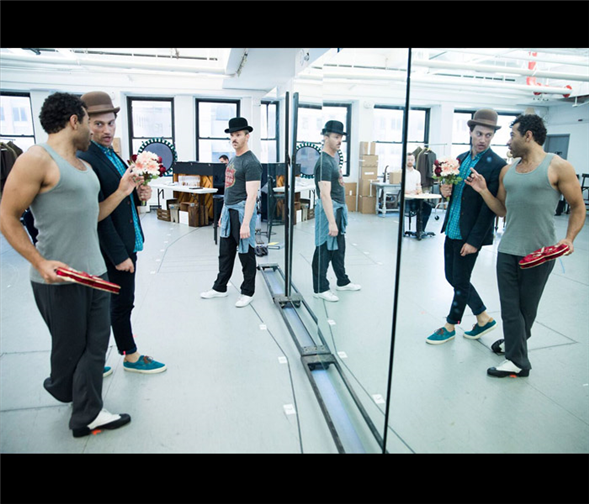Translate Page

How a cinematic trifle became a Broadway show
---
How do you turn a cinematic trifle into a big Broadway musical?
Holiday Inn, the 1942 film starring Fred Astaire and Bing Crosby, began as a vehicle for composer Irving Berlin to highlight a calendar's worth of evergreen songs, including "Easter Parade," "White Christmas," and "Happy Holidays."
But with six writers working on the screenplay – including playwright Elmer Rice – the script wasn't quite as sacrosanct as the music.
The plot follows two song-and-dance men named Jim and Ted. Lured by dreams of a rural life, Jim splits showbiz and buys a farm, but he soon discovers that he misses the performer's life. He turns the property into an inn that presents entertainment celebrating the major holidays, and soon enough, Ted is there to help. A beautiful woman named Linda also enters the picture, adding some romantic flair to the comic business.
Those basic elements are still part of the Broadway adaptation, which is now in previews at Studio 54, but don't expect a faithful recreation of the picture. The show may have been shepherded by Universal Stage Productions, which is the live theatre arm of NBCUniversal, but it's not being treated like a direct transfer of the movie.
As they developed the show, director Gordon Greenberg and seasoned TV writer Chad Hodge say they were given plenty of leeway. "We watched the movie two or three times to get the essence of the story, characters, and music," says Hodge. "And then we made it our own thing."
(That's partially why the musical is formally called Holiday Inn, The New Irving Berlin Musical. The title emphasizes that this piece is distinct not only from other Berlin-based shows, but also from the movie.)Hodge says he and Greenberg, who co-wrote the show's book, decided to use only a handful of songs from the film, knowing they could tap into the Berlin catalogue if necessary. But they didn't want to jam the tunes in for no reason. "Otherwise it's just another jukebox musical," Hodge adds. "Our main threshold is that it had to work for the character and the story."
{Image1}
With these changes – and a narrative that was reset to the more optimistic, post-WWII period – the show rode the Holiday Inn Express to Connecticut's Goodspeed Opera House, where it received encouraging audience and critical response in late 2014.
"We started to see that there was something to the show that was somehow larger than the sum of its parts," says Greenberg. "People walked away engaged and energized and delighted by the dance numbers and the musicality of the songbook, but also moved by the characters."
The show then went from Goodspeed's 380-seat theatre to one of the country's largest: the 12,000-seat outdoor Muny in St. Louis. The cast doubled, the orchestra tripled, and the stage was super-sized times four.
"It was a massive production and not easy to pull off," Greenberg recalls. "But even at that size we still felt there was a core connection with the audience. [We] saw what the possibilities could be with more dancers and a larger orchestra."
At that point Roundabout Theatre Company became interested, and after an additional workshop, it signed on to the show. An additional workshop added still more changes, including a sharper opening and more clarity for the characters.
For the Broadway production, there's an entirely new cast, headed by Tony nominee Bryce Pinkham as Jim and High School Musical alum Corbin Bleu as Ted.
And while is the show is still quite festive, a few of the holiday celebrations in the story have been diminished (Halloween) or dropped (Lincoln's Birthday – and no, the blackface musical number from the film was never considered for the stage version). What began as 10 holidays has now been trimmed to a more manageable half dozen: Thanksgiving, Christmas, New Year's, Valentine's Day, Easter, and Independence Day.
The Roundabout production has also cut several songs, including the standard "What'll I Do?". As Greenberg says, "it brought the character of Jim to a lower place than needed."
Meanwhile, a different Berlin standard was enlisted for a scene where Ted dances with Jim's girlfriend. To ruin Ted's romantic moves, Jim keeps changing the speed and rhythm of the song they're dancing to, which results in plenty of physical comedy. At Goodspeed and The Muny, however, this scene was scored with a lesser-known ditty, and audiences unfamiliar with the tune didn't know if the cadence changes were a joke or not. Now the scene uses "Cheek to Cheek," so when Jim throws in a rhythmic monkey wrench, the comedy connects.
Greenberg suspects there will be more tweaks during the preview period at Studio 54. (The official opening is October 6.) "It's the largest show presented at that space, he says. "And now we're just tightening the screws, making things clearer and clearer."
However, Hodge adds, "it's still the story we came up with when we began."
---
Follow Frank Rizzo at @ShowRiz. Follow TDF at @TDFNYC.
Photos by Jenny Anderson. Top photo (L to R): Corbin Bleu, Bryce Pinkham and Denis Jones in rehearsal for Holiday Inn.
TDF Members: Go here to browse our discounts for theatre, dance, and concerts.